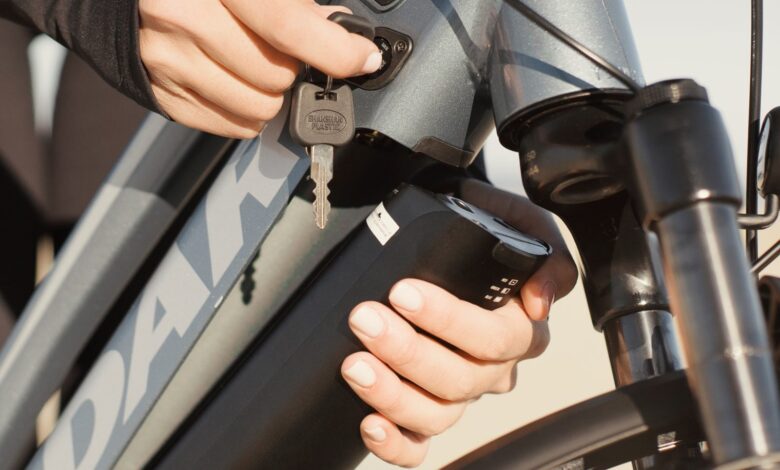How to Extend the Life of Your E-Bike Battery (Simple Tips That Work)

Your e-bike battery is the most expensive part of your bike and the one that wears out the fastest if not cared for properly. The good news? With just a few smart habits, you can make it last much longer.
In this guide, we’ll walk you through proven, real-world tips to help extend your e-bike battery’s life. From charging techniques to how you ride and store your bike, these tips can save you hundreds of dollars and keep your e-bike running stronger for years.
Whether you ride daily or occasionally, this guide will help you protect your battery, boost your range, and avoid early replacements.
How Long Do E-Bike Batteries Last?
Most e-bike batteries last between 500 and 1,000 full-charge cycles, depending on how they’re used and maintained. That means if you charge your battery every day, you can expect it to last 2 to 4 years. If you ride less frequently or follow good battery care practices, you can easily stretch that even further.
A full charge cycle means using 100% of the battery’s capacity—even if it’s not all in one go. For example, using 50% of your battery one day and another 50% the next counts as one full cycle. So riding in partial charges won’t “use up” a cycle as quickly.
According to a survey by BoltBikers, most riders report their batteries lasting around 3 years with regular use, while others get up to 5 years with proper maintenance. Of course, this depends on the type of battery, brand, riding conditions, and how well it’s treated.
It’s also worth noting that battery performance gradually drops over time. You may not notice much at first, but after a few hundred cycles, the range starts to shrink. That’s why it’s smart to start building good habits early.
How to Extend the Life of Your E-Bike Battery
The way you charge, ride, store, and care for your battery all affects how long it lasts. Here are the most effective, proven tips that make a real difference:
1. Avoid Charging to 100% Every Time
Topping off your battery to 100% every single ride might seem smart, but it actually stresses the battery over time. For daily use, it’s best to charge to about 80 to 90% unless you need full range that day. This helps reduce the strain on the battery cells and slows down long-term wear.
2. Don’t Let It Drain to Zero
Letting your battery drop to 0% or stay empty for long periods can cause damage and reduce its ability to hold a charge. Try to keep it above 20 to 30% whenever possible. Many battery management systems have a buffer to protect from full drain, but it’s better not to risk it.
3. Use the Right Charger
Always use the charger that came with your e-bike or one recommended by the manufacturer. Off-brand or fast-charging alternatives can overheat or overcharge your battery, reducing its lifespan or causing safety issues. If you lose your charger, get a verified replacement—not the cheapest option online.
4. Store It in a Cool, Dry Place
Batteries don’t like extreme heat or freezing cold. When not riding, store your e-bike indoors or remove the battery and keep it in a dry, climate-controlled space. If you’re not using it for weeks or months, aim to leave it at 50–70% charge and check it monthly to top up if needed.
5. Avoid Extreme Temperatures When Riding or Charging
Riding in cold or hot weather is okay, but be cautious. In high heat, avoid charging the battery right after a ride; it needs time to cool down. In cold weather, warm the battery to room temperature before charging. Never charge a frozen battery, as it can cause permanent damage.
6. Ride in Eco Mode More Often
The more power you use, the harder your battery works. Riding in eco mode or a lower assist level when possible helps reduce strain, especially on flat roads. Save the high-power modes for hills or heavy loads. This not only helps the battery but also extends your range per charge.
7. Keep the Battery Clean and Dry
Moisture and dirt can damage the battery contacts or lead to corrosion. Wipe the battery and its connectors with a dry cloth after wet rides. Avoid using high-pressure hoses near the battery area. Keeping it clean helps it run more efficiently and avoids small problems that can build up over time.
Storage Tips for Long Battery Life
How and where you store your e-bike battery plays a big role in how long it lasts. A few simple habits can prevent early wear and keep it healthy year-round.
- Store at room temperature: Keep the battery in a cool, dry place, ideally between 50°F and 77°F. Avoid hot garages or freezing sheds.
- Avoid full charge for long-term storage: If you’re storing the bike for weeks or months, keep the battery at around 50% to 70% charge. This reduces internal stress.
- Remove the battery from the bike: When not in use for long periods, take the battery off the bike to prevent phantom drain or connection corrosion.
- Check and recharge monthly: Batteries slowly lose charge, even when idle. Top it off monthly to avoid dropping below safe levels.
- Keep it dry and off the ground: Use a shelf or a storage rack, and avoid areas with high humidity or risk of water damage.
Signs Your Battery Might Be Failing
No battery lasts forever. Knowing the early warning signs of a failing e-bike battery can help you avoid getting stranded or stuck with reduced performance.
- Noticeably shorter range: If your bike used to go 40 miles per charge and now barely hits 25, your battery is wearing out.
- Takes longer to charge: A healthy battery charges steadily. Long or inconsistent charging is a red flag.
- Power cuts or surges: Sudden loss of assist or jerky power delivery can signal a damaged or aging battery.
- Battery feels very hot or swollen: Overheating, bulging, or odd smells are serious signs that the battery is unsafe. Stop using it immediately.
- Battery won’t hold a charge: If it drops from 100% to 30% within a few miles, it’s nearing the end of its usable life.
When to Replace Your E-Bike Battery
Most e-bike batteries need replacing after 3 to 5 years of regular use or about 500 to 1,000 charge cycles, depending on how well you care for them. After that point, performance drops and the battery may no longer hold a full charge.
A clear sign it’s time for a new battery is a consistent drop in range, even after a full charge. If you’ve already tried better charging habits and still find your battery underperforming, it may simply be worn out.
Many newer e-bikes have apps or battery management systems that show battery health. If your battery health indicator shows 70% or less and drops quickly with use, it’s likely nearing replacement time.
When shopping for a new battery, always stick with trusted brands and match the voltage, capacity, and connector type to your e-bike model. Avoid generic replacements unless they’re verified by your bike’s manufacturer.
Final Words
Your e-bike battery is the heart of your ride, and with the right habits, you can keep it strong for years. Small changes like avoiding full charges, staying out of extreme heat, and storing it properly make a big difference.
Most batteries last several hundred cycles, but smart riding and charging can help you stretch that even further. Watch for early signs of wear, and don’t wait too long to replace a failing battery; it’s better to stay ahead than get stuck mid-ride.
Whether you ride every day or just on weekends, following these simple tips will help you protect your investment and get more from every charge.




